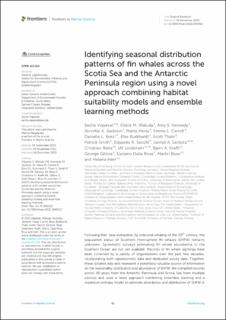Identifying seasonal distribution patterns of fin whales across the Scotia Sea and the Antarctic Peninsula region using a novel approach combining habitat suitability models and ensemble learning methods
Viquerat, Sacha; Waluda, Claire M.; Kennedy, Amy S.; Jackson, Jennifer A.; Hevia, Marta; Carroll, Emma L.; Buss, Danielle L.; Burkhardt, Elke; Thain, Scott; Smith, Patrick; Secchi, Eduardo R.; Santora, Jarrod A.; Reiss, Christian; Lindstrøm, Ulf Ove; Krafft, Bjørn Arne; Gittins, George; Dalla Rosa, Luciano; Biuw, Martin; Herr, Helena
Peer reviewed, Journal article
Published version

View/
Date
2022Metadata
Show full item recordCollections
- Articles [3009]
- Publikasjoner fra CRIStin [3056]
Abstract
Following their near extirpation by industrial whaling of the 20th century, the population status of Southern Hemisphere fin whales (SHFW) remains unknown. Systematic surveys estimating fin whale abundance in the Southern Ocean are not yet available. Records of fin whale sightings have been collected by a variety of organisations over the past few decades, incorporating both opportunistic data and dedicated survey data. Together, these isolated data sets represent a potentially valuable source of information on the seasonality, distribution and abundance of SHFW. We compiled records across 40 years from the Antarctic Peninsula and Scotia Sea from multiple sources and used a novel approach combining ensemble learning and a maximum entropy model to estimate abundance and distribution of SHFW in this region. Our results show a seasonal distribution pattern with pronounced centres of distribution from January-March along the West Antarctic Peninsula. Our new approach allowed us to estimate abundance of SHFW for discrete areas from a mixed data set of mainly opportunistic presence only data.